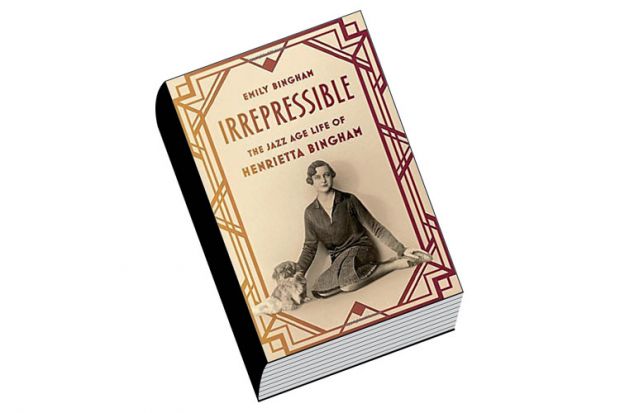Henrietta Bingham, the dust jacket of Irrepressible asserts, “ripped through the Jazz Age like an F. Scott Fitzgerald character: intoxicating and intoxicated, selfish and shameless, seductive and brilliant, endearing and often terribly troubled”. Emily Bingham’s sensitive pursuit of the hidden history of her great-aunt, launched by the discovery of a collection of extraordinary love letters and their revelations, deserves better than this hyperbole.
The Henrietta that emerges from her painstaking research through the traces of forgotten and suppressed history is a far more complex and vulnerable figure than the heavy-drinking, bisexual It girl, dependent and manipulative, of previous biographies of the Bingham family. Born into the elite of Louisville, Kentucky, the 12-year-old Henrietta lost her mother in a car crash. After the accident, her father Robert made her his main emotional support, doting on her, indulging her, depending on her but also controlling her. When he married again, to Mary Lily Flagler, the wealthiest widow in the US, Henrietta felt abandoned and was furiously jealous.
Her father’s new wife, a secret alcoholic and morphine addict, would die only a year later, but not before she had written a codicil to her will, changing the prenuptial agreement signed on their marriage to leave Robert a staggering $5 million. Although he would never quite shake off the rumours of foul play that swirled around her death, the inheritance allowed him to pursue his publishing business and political ambitions. In 1921, he enrolled his daughter at Smith College in Massachusetts, hoping that she would earn a degree. Henrietta had little appetite for study, but she did meet Mina Kerstein, the young academic who would become the first in a string of her lovers to compete with her father in influence.
Fleeing to London, the two women began psychoanalysis with Ernest Jones and met David Garnett, their point of entry into the Bloomsbury set, with its liberal social and sexual mores. For “lower-Bloomsbury”, Henrietta’s southern American background and Prohibition-strength cocktails seem to have held an exotic allure (although Vanessa Bell apparently found her “irritating”). The sculptor Stephen Tomlin fell very much in love with her, as did Dora Carrington. She nearly married Tomlin, while with Carrington she enjoyed a passionate fling, but both affairs were broken off when her father called for her to return home.
This would become the pattern of Henrietta’s transatlantic lifestyle for the next decade, as she made repeated bids for emotional and sexual independence in Europe before returning in submission to tend to the needs of her father in Kentucky. Robert’s third marriage and role as US ambassador to the UK in the 1930s brought a resolution of sorts, with his wealth and position providing a cushion of respectability for his daughter’s relationships. When Henrietta fell in love with the American tennis champion Helen Jacobs, her father welcomed the sportswoman as a guest in his household, even providing the couple with a hunting retreat in the Buckinghamshire countryside.
These would seem to have been the happiest (and healthiest) years of Henrietta’s life, but they ended with her father’s death in 1937. Over the increasingly intolerant decades of the 1940s and 1950s, Henrietta spiralled into alcoholism, depression and barbiturate dependency, constantly fearing confinement until her death in 1968. In assembling the tantalising glimpses that remain of her restless effervescence – not just in that trunkful of letters but also in the portraits, diaries and memoirs of others who were so drawn to her – Irrepressible recovers something of the woman behind the Jazz Age stereotype. After all, as her great-niece notes, “Henrietta’s lovers heard her voice, felt her breath on their skin, and knew her touch”.
Deborah Longworth is senior lecturer in English, University of Birmingham. She is author of Streetwalking the Metropolis: Women, the City and Modernity (2000) and co-editor of The Oxford Handbook of Modernisms (2007).
Irrepressible: The Jazz Age Life of Henrietta Bingham
By Emily Bingham
Farrar, Straus & Giroux, 384pp, £18.99
ISBN 9780809094646
Published 25 July 2015
Register to continue
Why register?
- Registration is free and only takes a moment
- Once registered, you can read 3 articles a month
- Sign up for our newsletter
Subscribe
Or subscribe for unlimited access to:
- Unlimited access to news, views, insights & reviews
- Digital editions
- Digital access to THE’s university and college rankings analysis
Already registered or a current subscriber?




